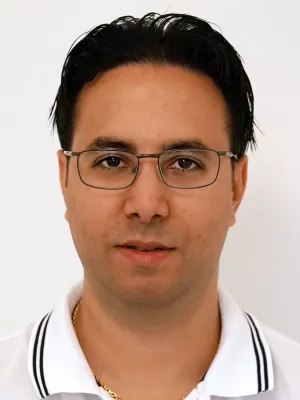
Rafi Sheikh
Research project participant

Blood Perfusion in Rotational Full-Thickness Lower Eyelid Flaps Measured by Laser Speckle Contrast Imaging
Author
Summary, in English
PURPOSE: Large upper eyelid defects can be repaired by rotational full-thickness lower eyelid flaps. The aim was to measure the blood perfusion in such flaps, and how it is affected by the length of the flaps, and the degree of rotation and stretching.
METHODS: Nine patients underwent the Quickert procedure for entropion repair in which a full-thickness eyelid flap of approximate width 0.5 cm and length 2 cm was dissected in the lower eyelid. This generates a full-thickness eyelid flap similar to that used to repair large upper eyelid defects. Perfusion was measured using laser speckle contrast imaging, before and after the flap was rotated 90° and 120°, and stretched using forces of 0.5, 1, and 2 N.
RESULTS: Blood perfusion decreased gradually from the base to the tip of the flap; being 75% of the reference value 0.5 cm from the base, 63% at 1.0 cm, 55% at 1.5, 23% at 1.75 cm, and 4% at 2.0 cm. Rotating the flaps by 90° or 120° had little effect on the perfusion. Stretching reduced the perfusion from 63% to 32% at 2 N, when measured at 1 cm. The combination of stretching and rotation did not lead to any further decrease.
CONCLUSIONS: Blood perfusion in lower eyelid rotational flaps seems to be more sensitive to stretching than to rotation. Provided the flap is no longer than 1.5 cm, the perfusion will be greater than 20%, even when rotated, which should be sufficient for adequate survival and healing.
Department/s
- Ophthalmology Imaging Research Group
- Ophthalmology, Lund
- StemTherapy: National Initiative on Stem Cells for Regenerative Therapy
- Thoracic Surgery
Publishing year
2020-03
Language
English
Pages
148-151
Publication/Series
Ophthalmic Plastic and Reconstructive Surgery
Volume
36
Issue
2
Document type
Journal article
Publisher
Lippincott Williams & Wilkins
Topic
- Ophthalmology
Status
Published
Research group
- Ophthalmology Imaging Research Group
ISBN/ISSN/Other
- ISSN: 1537-2677

